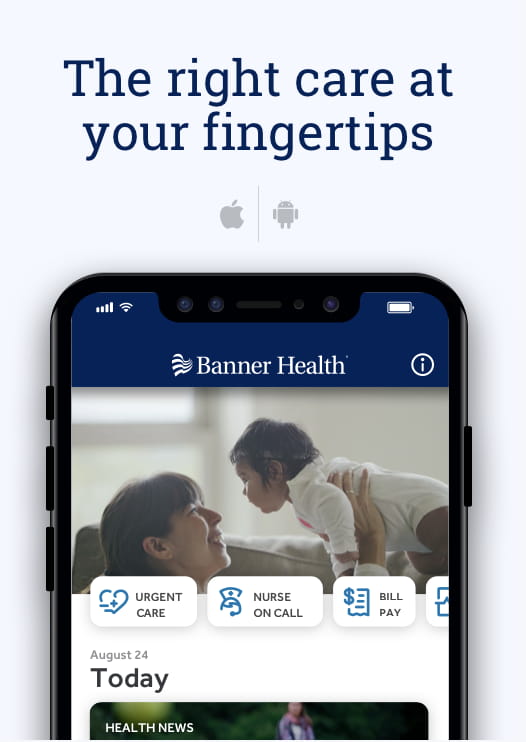When preparing for your baby’s arrival, it’s natural to want things to go as smoothly as possible. Creating a birth plan is an opportunity to pave the way for a positive birthing experience.
With the help of Bailey Bylow, an OBGYN nurse practitioner with Banner – University Medicine, we will walk you through the ins and outs of creating a birth plan that suits your preferences and helps you feel more confident on the big day.
The role of a birth plan
First things first: What exactly is a birth plan?
“A birth plan lays out your wishes for labor, delivery and after childbirth,” Bylow said. “It’s a way of telling your health care team your personal preferences.”
For example, your birth plan may include preferences like:
- The type of lighting, music played and “vibe” you want in the delivery room
- Who do you want in the room for support, like your partner, a doula or another support person
- Pain relief, such as epidural, medication or natural methods
- Positions you would like to use during labor
- Cultural or religious beliefs and practices that should be respected
- Choices for cord blood banking
- Immediate postpartum care, like skin-to-skin contact with your baby or delayed cord clamping
You can use a sheet of paper or a simple birth plan that you can download and fill in. That said, if you don’t have a written plan, don’t sweat it. It can be as simple as ongoing conversations between you, your provider and support staff at the hospital or birthing center.
“We aren’t going to hold anyone to their birth plan; it can evolve and change at any point,” Bylow said. “Your health care team wants you to have the birth experience you desire while also maintaining the underlying goal of having a safe delivery for you and the baby.”
Tips for preparing your birth plan
The prospect of creating a birth plan is both exciting and a tad overwhelming. Fret not! We’re here to help.
Here are four helpful tips for creating a birth plan tailored just for you.
1. Start early
Begin your birth plan journey early in your pregnancy. This gives you plenty of time to research, gather information and ask your health care provider questions.
“I encourage patients to look at generic birth plans well before their delivery and to come back to future visits with questions,” Bylow said. “This will spark conversations about pain management, pediatricians, breastfeeding, postpartum expectations and other situations they may not have previously considered or even known anything about.”
Here are some questions you may ask your provider as you consider your birth plan:
- What hospitals or birthing centers are you affiliated with?
- If I think I’m in labor, when should I go to the hospital or birthing center?
- What happens if you aren’t available when I go into labor?
- How far past my due date do you recommend we wait?
- Do you support natural childbirth?
2. Understand the labor preferences available to you
Tour possible hospital or birthing center locations to get a feel for the environment, understand the available services and ask any questions you may have.
“This will help you familiarize yourself with the birthing rooms, flow from check-in to delivery to postpartum to discharge,” Bylow said. “It also allows you to see firsthand what is available during and after delivery, such as birthing tubs, birthing balls, etc.”
Here are some questions that you may want to ask during your tour:
- Can you walk me through the typical process at this birthing center or hospital?
- What medicines and drug-free options are available to manage pain?
- How flexible are you with allowing different labor and pushing positions?
- What postpartum care services are available?
- How soon after delivery can I bond with my baby?
- How are emergencies handled?
Taking birthing classes can also help you understand and explore your preferences. These classes typically cover birthing options, pain management techniques and possible interventions or medical procedures. This knowledge can help enhance your preparedness and confidence for the big day.
3. Share your preferences
Once you have prioritized what matters most to you in your birth experience, discuss your birth plan with your health care team and your support person before your due date. Your support person can be your spouse, partner, doula or someone who will be with you during labor and delivery and can communicate your wishes when you cannot.
State your preferences clearly and concisely, avoiding vague language and jargon.
Remember, your birth plan is a guide. It’s not a set of rules. You can update your birth plan anytime – even during labor and delivery.
4. Plan for the unexpected
Even with all your research and early planning, things may go differently than you pictured on the big day.
Maybe you were hoping for a vaginal delivery but suddenly need to have an emergency C-section. Or perhaps your provider is not available, and another provider is on-call.
“The goal is always to try and give you the birth experience you desire, but sometimes the plan may need to change to keep both mom and baby safe,” Bylow said. “Sometimes the hospital can’t accommodate everything on a birth plan, and sometimes the baby will have their own plan.”
Your health care team has your best interests at heart. They may suggest new things that you hadn’t considered. Be open to their suggestions and discuss them with your support person.
Takeaway
Creating a birth plan is a wonderful way to take an active role in your birthing experience. Open communication and flexibility can help ensure a positive birth experience for you and your baby.
Schedule an appointment with your health care provider or a Banner Health specialist and begin planning your ideal labor and delivery experience.


